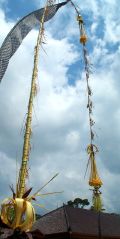Temples
February, 2003
1. Public temples —
The public temples of Bali are very important in modern Balinese society. Ceremonies and prayer are a critical part of daily life here. However, the temples are so numerous, and their meaning in the lives of the (mostly) Hindu people who live here is so complex, that we cannot possibly offer a useful summary in so little space. So, instead, we offer the following snapshots of the beauty of the temples, with no attempt at an explanation of their religious significance.
2. Family home temples —
 |
| Family home temple (120k)
|
|
|
|
Each family has its own home temple compound, called a Sanggah. In it are the temples to honor the Hindu gods and the family's ancestors. The alignment and positioning of the Sanggah within the family compound is determined by tradition. Offerings are placed here twice each day, and there are frequent ceremonies for births, deaths, etc. The number of family ceremonies is staggering, and expensive.
The temples consist of a stone and brick base with a wooden top. There is a roof of some sort to protect the wood. (Temples to demons -- there are good demons, as well as bad -- are made of concrete, stone, and/or brick.) Construction of the temple base begins with large boulders which are cut into the appropriate size with a saw, and then laboriously chiseled into the appropriate shapes by hand. The chisels are quickly dulled from the work and must be resharpened and tempered frequently. The temples are built up from small pieces of stone and brick which are fitted together temporarily at the workshop, then taken to the customer's home to be assembled with concrete for a permanent installation.
The actual temple is made of wood. Individual parts of the temple, such as this molding, are hand carved in small shops. The final assembly is done in another shop. The finished temple can be left unfinished, or it can be painted or gilded depending on the owner's wealth. Most Balinese seem to have the most ornate temples that they can afford. As the wood will deteriorate rapidly if left out in the rain, it must be protected with a roof. The best, longest lasting roofs are made from a coarse black fiber obtained from the jaka palm tree, grown especially for this purpose. The roof is installed something like a thatched roof over a wooden framework.
|
3. Offerings —
4. Ceremonies —
 |
| Penjor (60k)
|
|
|
|
We were lucky to be in Bali during the annual ceremonies at the Pura Agung (Agung Temple) in Taro Village in central Bali. The villagers here continue many of the old traditions that have been lost in other places.
During the ceremony, the temple's many buildings are covered in offerings. Each family contributes its own offering, and there must be hundreds, perhaps thousands, of participating families. There isn't room for all the offerings, so some of them must be suspended from the rafters. We visited the temple the day before the ceremony and watched the preparations. Here, the priests are offering prayers to bless the many offerings. The essence of the offering is given to the Gods. Each family will retrieve the physical offering after the ceremony. The food is taken home and eaten for good luck.
This ceremony is the major event in the village each year. Large quantities of food are prepared within the temple and vendors also set up a tent city on open ground nearby. Huge numbers of people attend from all over Bali. (We aren't terribly comfortable in large crowds, so we decided to miss the actual event.)
|
|